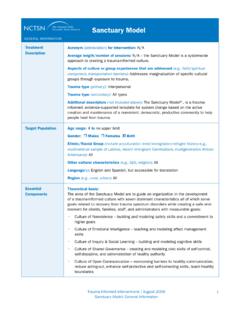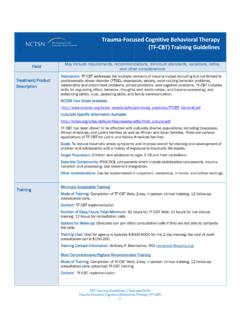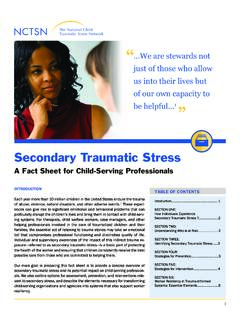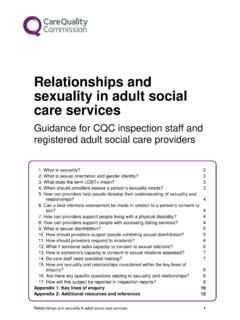Transcription of Gender-Affirming Care Is Trauma-Informed Care
1 Gender-Affirming Care Is Trauma-Informed Care Major medical associations recognize Gender-Affirming care as the standard of care for transgender, gender diverse, and intersex (TGI) youth. Gender-Affirming care broadly refers to creating an environ- ment that facilitates youth to move through the world safely as the gender they know themselves to be. This includes developmentally appropriate, evidence-based care provided by medical and mental health experts in partnership with youth, parents, and caregivers. It may include evidence-based interventions such as puberty blockers and Gender-Affirming hormones. Gender-Affirming care also includes access to opportunities that all children should have, such as playing team sports, safely using bathrooms in their schools and other public places, and positive relationships with supportive adults. Providing Gender-Affirming care is neither child maltreatment nor malpractice. The child welfare system in the US, charged with improv(ing) the overall health and well-being of our nation's children and fami- lies, 1 should not be used to deny care or separate families working to make the best decisions for their children's well-being.
2 There is no scientifically sound research showing negative impacts from providing Gender-Affirming care. The decision for the child welfare system to become involved in the lives of fami- lies, potentially to the extent of removing children from their families and homes, should be wielded with the utmost care, grounded in evidence, and always prioritizing the well-being of children and preserva- tion of families. It has been well-documented that TGI youth experience trauma, discrimination, and health disparities at higher rates than their cisgender peers, including disproportionate rates of negative behavioral health outcomes and higher rates of attempted ,3 Trauma exposure for TGI youth also includes the trauma of experiencing oppression when their identities are rejected by individuals in their lives, in their communities, or in the broader public. Alternatively, affirmation from families has been shown to be a protective factor against attempted suicide, depression, substance misuse, and other negative health Consistently using youth's chosen names and pronouns reduces suicidality and Gender-Affirming medical care, particularly puberty blockers and Gender-Affirming hormones, reduces rates of depression, suicidal ideation, and other serious behavioral health TGI youth can thrive when they are supported and affirmed in their identities and their identity devel- opment, when they have open and affirming school environments where they can talk about their ex- periences, and when their families are resourced to make the best evidence-based care decisions in collaboration with their providers.
3 We have the tools to increase TGI youth's current social, emotional, and physical well-being and to support them to imagine and experience a future in which they can thrive and live full, happy lives. You can help keep TGI youth safe by expressing your support and acceptance and finding ways to partner with others to create affirming and supportive environments. Here are some practical suggestions for what you can do: Take responsibility for your own knowledge and understanding of gender diversity by staying up-to-date on evidence-based research and best practice, attending trainings, and reading work by transgender and gender diverse writers to understand more about the language and experiences of TGI youth. This will enable you to better establish safety, build trust, and provide better quality care. Recognize that despite what you've learned, you may not always be sure what something means, especially related to an individual's identities or experiences. It is okay to ask in a respectful and genuine manner.
4 This project was funded by the Substance Abuse and Mental Health Services Administration (SAMHSA), US Department of Health and Human Services (HHS). The views, policies, and opinions expressed are those of the authors and do not necessarily reflect those of SAMHSA or HHS. Believe and validate youth when they share their gender identities with you by always using and validating the names, pronouns, and identities that youth share with you, even if those change while they are exploring their identities. Many children are aware of their own gender identity as early as 3-5 years old,7,8 although it is also common for children to explore gender identity at later ages. Cisgender children are trusted to know and understand their gender , and social norms and customs validate their identities regularly. TGI youth deserve the same trust and validation. As parents, caregivers, and providers, you are responsible to communicate this validation by actively affirming their identities. Avoid assumptions and misinformation by familiarizing yourself with how medical experts de- fine the standard of care for transgender youth and what these treatments entail.
5 Seek reliable sources such as the World Professional Association for Transgender Health, American Academy for Child and Adolescent Psychiatry, and the American Academy of Pediatrics. Be prepared to share information, resources, and research with families as they decide how to achieve their care goals. Proactively seek out and build relationships with local service providers who specialize in care for TGI youth in order to create a supportive network and provide reliable referrals to TGI youth and their families. These services are not accessible in every community, and virtual/telehealth connections may be necessary to create a supportive network. Identify the nearest places to you where youth and their families can access this care, including resources to help address added travel burdens or reliable internet access limitations. Prioritize using resources created by transgender and gender diverse experts by identifying and connecting with transgender and gender diverse providers and organizations- nationally and in your community as partners and trainers.
6 Make sure to compensate these experts for their resources equitably. Recognize your responsibility to actively ensure that your space accepts and affirms TGI youth, both as an organization and an individual provider. This includes reviewing your practices, pol- icies, and paperwork for bias, ensuring all staff are trained, and being proactive and consistent when communicating with youth and families about trust, confidentiality, and clients' rights. Stay up-to-date with national and local policies and protections related to Gender-Affirming care to ensure youth and their families understand their rights. Be aware of how public discourse and changing legislation may create or exacerbate confusion and mistrust about healthcare services, systems, and providers. Communicate with TGI youth and families about their rights and risks in their communities and the resources available to them. Be mindful that young people are aware of the national conversations about access to gen- der-affirming care and the rights of LGBTQ+ youth, and acknowledge that any feelings or fears that arise from witnessing prejudice towards LGBTQ+ youth are valid.
7 Be prepared to offer a space for them to process, ask questions, and plan for their safety. Create space for youth to explore the fullness of their gender and other cultural identities with- out fear of judgment or harm. Recognize how intersecting marginalized identities including race, ethnicity, religion, ability, socioeconomic status, and mental health status can reduce access and amplify the impact of rejection and fear of consequences for accessing Gender-Affirming care. 2. Assist youth, parents, and caregivers with family safety planning by helping them create a safe folder. This folder can include letters from providers ( , medical, mental health) and community members ( , neighbors, spiritual leaders, school representatives) communicating that parents/. caregivers are not harming their child and that the child is benefitting from their care. Parents and caregivers can use this folder should they need to justify the affirming and supportive care they are providing for their child.
8 Communicate to TGI youth and families that many people are working hard to support them and make sure they have access to the care they need and deserve. TGI youth need to know they are not alone and that there are supportive adults who care about them and are working hard to make sure their needs can be met. Support and empower young people and their families to take action by encouraging them to connect with culturally affirming peer communities for mutual support and to take part in local or national advocacy efforts. Advocacy, especially in community, can be a core aspect of healing from collective and oppression-based trauma. Educate your community partners ( , child welfare, schools), policymakers, and the general public by sharing resources and information about Gender-Affirming care and offering or host- ing trainings. Research and share information about the positive, protective impacts of gender -af- firming care for children and families. Share the benefits and savings to our healthcare and child welfare systems when we prevent negative health outcomes and preserve Provide re- sources created by transgender and gender diverse experts, and offer opportunities to amplify their work by inviting them as trainers or speakers.
9 As always, equitably compensate transgender and gender -diverse experts for their work. Keep working to recognize and shift your own biases and assumptions by continually asking yourself questions about the power and privilege you have based on your own gender identity, sexu- al orientation, race, provider status, and other aspects of your intersectional identities. Support and challenge your colleagues and collaborative partners to do the same, and build spaces to explore layers of seen and unseen privilege and oppression. Be aware of the impact on you or your colleagues who are providing Gender-Affirming care and who themselves or whose loved ones hold transgender and gender diverse identities. Acknowl- edge and honor the weight of witnessing and bearing the pain and anxiety experienced by the children and families served as well as the personal impact. Relevant NCTSN resources include: Affirming Care for Transgender and gender Expansive Youth (webinar). Identifying the Intersection of Trauma and Sexual Orientation and gender Identity: o Part 1: Key Considerations o Part 2: The Screener o Webinar Engaging Families in Affirming Trauma-Informed Care for LGBTQ Children and Youth (webinar).
10 3. Safe Places, Safe Spaces: Creating Welcoming and Inclusive Environments for Traumatized LGBTQ Youth o Resource Guide o Video o Webinar Assisting Parents/Caregivers in Coping with Collective Traumas Other NCTSN resources to support LGBTQ+ youth and provide affirming care can be accessed: Additional Partner Resources Statement by HHS Secretary Xavier Becerra Reaffirming HHS Support and Protection for LGBTQI+ Children and Youth American Academy of Child & Adolescent Psychiatry: Clinical Guidelines & Training for Pro viders, Professionals, and Trainees Trans Lifeline National SOGIE Center Family Acceptance Project A Practitioner's Resource Guide: Helping Families to Support Their LGBT Children gender Spectrum Education and Training Trans Student Educational Resources American Academy of Child & Adolescent Psychiatry gender and Sexuality Resources Human Rights Campaign: All Children-All Families The Trevor Project It is critically important that TGI youth know many adults are working hard to ensure their safety and access to Gender-Affirming care.













